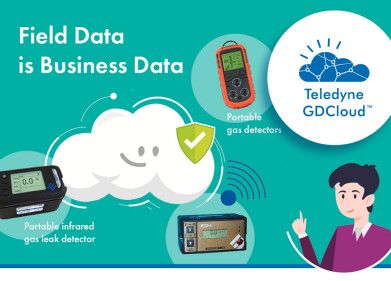Personal gas detector
New Portable Gas Detector Puts an End to Costly, Time-Consuming Leak Surveys
May 28 2014
Detection of gas leakage with the flame ionization and semiconductor technologies used to date is time-consuming and cost-intensive. They require close approach to the leak location, which can be risky for leaks far above ground level or in hazardous areas. Esders GmbH (Germany) has now developed a solution to this problem: a laser detector which senses gas leakage, even in difficult-to-access locations, at distances up to 30 m. ELLI (Esders Laser Leak Indicator) is a portable gas monitor which is used to locate leaks from gas supply stations, biogas or industrial plants and gas lines, even those situated well above ground level. The detector senses methane concentrations even through double-pane windows in buildings.
"In biogas fermenters for instance, the seals around agitator shafts are often not completely airtight." explains Sebastian Wilkens, Product Manager at Esders GmbH. "The biogas emitted is typically over 50 % methane, which ELLI detects selectively". Gas leaks can be encountered in other systems as well including industrial plants, gate stations, compressor stations, gas storage facilities, etc. Leak surveying procedures used to date require close-up scanning with hand-held probes over the entire gas-carrying system. Problems are posed by areas which are inaccessible, hard to reach or located in hazard zones requiring use of personal protective equipment. In contrast, the TDLAS (Tunable Diode Laser Absorption Spectroscopy) remote sensor technology incorporated in ELLI reliably detects methane at safe distances up to 30 m. Detection at greater distances is possible as well under favourable reflective conditions.
"Simply point the laser beam at the area you want to check." explains Wilkens. The ELLI detector, compactly sized with dimensions of 213 x 155 x 66 mm, measures methane concentration by determining the difference in intensity of the infrared laser beam when emitted and when reflected back. The measurement takes place at a specific wavelength to ensure selective detection of methane. The reading is displayed in units of ppm · m, i.e. the product of the methane concentration between the detector and the target and the path through the gas plume. ELLI senses methane over a detection range from 0 to 50,000 ppm · m.
The results of the detector check, which can be carried out at ambient temperatures ranging from -17 °C to + 50 °C, are shown with a lag time of only 0.2 seconds on a colour LCD touch panel display. The monitor indicates even the smallest methane accumulations or leakage in virtually real-time operation. Hazardous readings are accompanied by an audible warning alarm with user-definable settings.
Digital Edition
AET 28.4 Oct/Nov 2024
November 2024
Gas Detection - Go from lagging to leading: why investment in gas detection makes sense Air Monitoring - Swirl and vortex meters will aid green hydrogen production - Beyond the Stack: Emi...
View all digital editions
Events
Jan 12 2025 Abu Dhabi, UAE
Jan 14 2025 Abu Dhabi, UAE
Jan 20 2025 San Diego, CA, USA
Carrefour des Gestions Locales de L'eau
Jan 22 2025 Rennes, France
Safety, Health & Wellbeing LIVE
Jan 22 2025 Manchester, UK



















